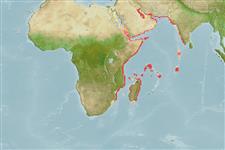Common names from other countries
Classification / Names / Names
Nomes comuns | Sinónimos | Catalog of Fishes (gen., sp.) | ITIS | CoL | WoRMS
Environment: milieu / climate zone / depth range / distribution range
Ecologia
; intervalo de profundidade 0 - 24 m (Ref. 107695). Tropical
Western Indian Ocean.
Length at first maturity / Tamanho / Peso / Idade
Maturity: Lm ? range ? - ? cm
Minimum depth from Ref. 1726. Intertidal to shallow subtidal. Found under medium-sized granite rocks or dead coral slabs, slightly buried in coarse sand (Ref. 1726). Most chitons are microphagous feeders that consume fine algae and other organisms they scrape via their radula (Ref. 833).
Life cycle and mating behavior
Maturidade | Reprodução | Desova | Ovos | Fecundidade | Larvas
Members of the class Polyplacophora are mostly gonochoric. Life cycle: Eggs hatch into lecitotrophic planktonic trocophore larvae (no veliger stage) which later metamorphose and settle on the bottom as young adults.
Dell'Angelo, B., A. Bonfitto, M. Taviani and B. Sabelli. 2003. (Ref. 703)
Categoria na Lista Vermelha da IUCN (Ref. 130435)
Categoria CITES (Ref. 108899)
Not Evaluated
Not Evaluated
Ameaça para o homem
Harmless
Utilização humana
| FishSource |
Ferramentas
Mais informação
Nomes comunsSinónimosPredadoresReproduçãoMaturidadeDesovaFecundidadeOvosDesenvolvimento dos ovos
Idade/Tamanho
Crescimento
Comprimento-peso
Comprimento-comprimento
Morfologia
Larvas
Abundância
Fontes da internet
Estimates based on models
Preferred temperature
(Ref.
115969): 26.2 - 29, mean 27.5 (based on 543 cells).
Categoria de preço
Unknown.
